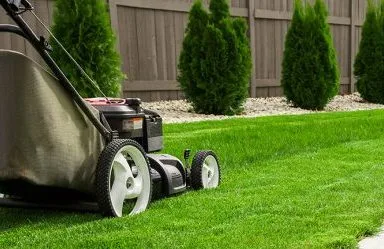Keeping a north Texas lawn healthy and green is no easy task. When it comes to taking care of your grass, there are a few key factors to consider. You want to take certain steps to keep your specific grass type strong and attractive.
Here are the basics:
- Amount and Frequency of watering
- Optimal Mow Height
- How Often to Mow
Here in North Texas, we have 3 main grass types that are most popular for commercial and residential turfs. All 3 thrive in our region’s climate, weather patterns, and soil consistency, but each one has slightly different needs.
Grass types to discuss:
- St Augustine
- Zoysia
- Bermuda
Let’s take a closer look at best practices for lawn maintenance of each grass.
St Augustine
When it comes to maintaining St Augustine grass, you want to make sure that you water when the grass changes color or when rain has not been present for 3 to 4 weeks, when the grass looks darker or starts to feel dry, you want to spend 20 to 30 minutes watering the grass.
A good regular schedule includes watering 2 or 3 times per week, for about 15 to 20 minutes. Of the 3 grass types, St. Augustine is the least drought resistant, so it is important to keep it irrigated. Learn more about how to care for your St. Augustine grass.
When it comes to mowing, you need to make sure that the height is a minimum of 2.5” inches and a maximum of 3” inches. Any less than this and you risk damaging the grass or needing to cut it more often. Professionals recommend never removing more than 1/3 of the total length.
RELATED TIP: Can I Landscape in the Fall?
It’s good practice with St. Augustine grass to use the clippings as mulch for the grass. This will not only help add nutrients to the grass, but also helps the soil hold nutrients for a longer period of time.
Zoysia
Zoysia is a much tougher type of grass and does not need to be watered as frequently as St. Augustine. Thirsty Zoysia grass will let you know it needs more watering by showing dry and curled blade tips. In fact, some experts say it really doesn’t need to be watered at all unless your area is experiencing a prolonged drought.
A good regular schedule includes watering once or twice per week, for about 15 minutes. As our region typically has clay-heavy soil, you can sometimes get away with watering Zoysia grass a bit less even, to conserve resources.
When cutting, you want to keep your Zoysia grass at about 2 inches in length. As with St. Augustine, you risk damage when cutting shorter. Additionally, allowing the blades to grow beyond 3.5 inches can block too much light from reaching the base of the grass bed.
You may not want to leave the clippings behind as mulch. With this particular grass type, doing so can pose a risk of “crowding” the base and the topsoil. This is because Zoysia’s growth pattern is naturally denser than St. Augustine and Bermuda grass.
Bermuda
Bermuda grass typically needs about 1 inch of water per week, or a depth of six inches soaked into the soil. It prefers to be watered deeply rather than frequently. It’s considered fairly drought tolerant, like Zoysia grass.
RELATED TIP: Best Colors for annual Flowers for North Texas
Watering 3 times a week for about 20 minutes is adequate, but your Bermuda grass may benefit more from a once-per-week watering schedule. Depending on the local temperature, you can adjust accordingly, aiming for whichever schedule will allow the most absorption into the topsoil.
When it comes to cutting Bermuda grass, you can go a bit shorter than with the other two. Keep in mind the rule of 1/3 the blade. This grass can thrive between 1.25 and 2 inches in length.
You may need to mow more frequently to maintain a shorter blade height. As with St. Augustine grass, allowing Bermuda grass to get too long can block sunlight from the turf’s base.
Final Thoughts
For all 3 grass types, there are a couple of common rules to keep in mind despite the slight differences in general lawn maintenance. Even when mowing lower for winter lawn preparation, you still don’t want to set the mower blades so low that you risk scalping your lawn. Additionally, don’t overwater your grass, as excessive moisture that hasn’t soaked into the soil can invite fungal diseases and weeds.



Comments (0)
Thanks for your comment!
Thanks for your feedback! Your comments have been successfully submitted! Please note, all comments require admin approval prior to display.
Error submitting comment!
There is a problem with your comment, please see below and try again.